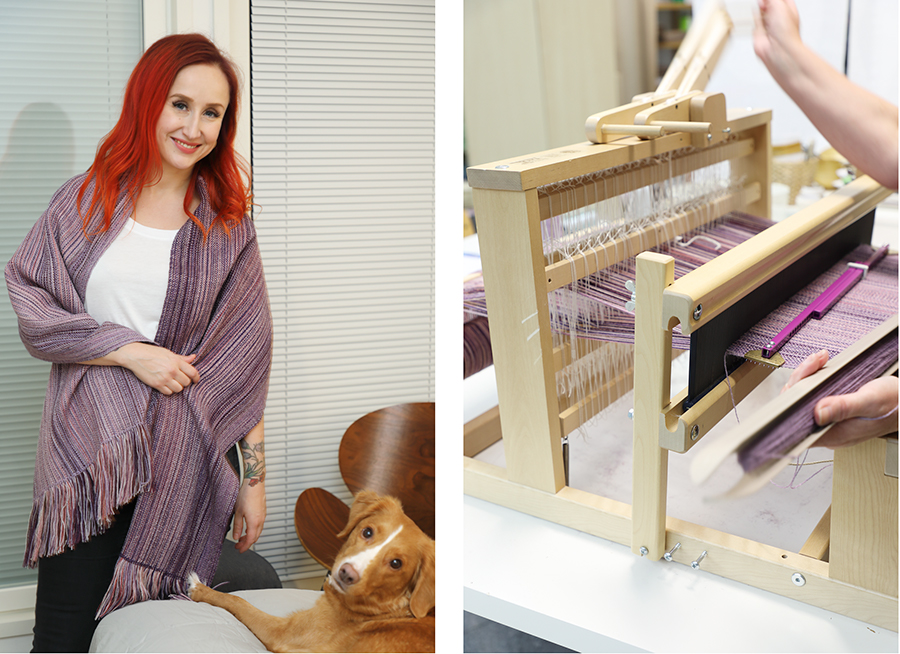We went through our yarn stash! The idea was to weave a scarf with mixed yarns of different fibers and weights in the warp. Maarit had previously emptied out great yarn stashes by winding warps with this technique. We carried out the same procedure on a smaller scale with a table loom.
| The Warp | Mixed yarns of different fibers and weights |
| Warp | density 8 threads/cm (single and double) number of warp ends: 96 portees (2 portee = 1 cm. Each portee has 4 single or double ends) amount of warp yarns needed 260 g |
| Length | 2,8 m |
| Reed | 40/10 (40 dents per 10 cm) |
| Weave | Plain weave |
| Weft | One of the fine weight yarns that was also used in the warp |


Warp yarns:
Dark purple and purple: Kamena, 100 g = n. 455 m (100 % wool, hanks in the back).
Ligth beige: Rowan fine lace, 50 = 400 m (80 % baby alpakka, 20 % merino wool, skein).
Multicoloured pink and multicoloured rosa: Manos del Uruguay, 50 g = 400 m (70 % baby alpakka, 25 % silk 5 % cashmir).
Dark purple and purple: Esito combwool, 100 g = n. 425 m (100 % wool, cones).
Ligth pink and old rose red: Kamena, 100 g = n. 455 m (100 % wool, hanks in the front).
Multicoloured purple: 7-veljestä, 100 g = n. 200 m (80 % wool, 25 % polyamid, not in the picture).
NSTRUCTIONS FOR WARP DESIGN
The warp was designed quickly by picking up the suitable yarns from the stash containers. After that, we wound the warp combining different yarns in the same portee. The sett was approx. 8 single or double ends per cm. The threads were sleyed in a 40 dent reed. A portee is made by combining different yarns in a way that two fine yarns represent one single yarn. The portees should be as thick as four medium weight yarns. In this way, one portee might have for example 4 fine yarns and 2 medium yarns. The width of the warp is determined by the portees, not by warp ends like usually. Two portees = 1 cm. There are two portees pre-sleyed in each dent of the raddle. The yarns are pretty fine weight!
One portee is divided randomly and threaded in two heddles. The reed is sleyed by sleying each heddle’s threads in the same dent. The warp is dense, and it will be woven with a fine weight yarn with plain weave, so the warp threads will be clearly visible. The scarf becomes beautifully variegated with a lively surface.
If you use thicker yarns for the warp, use 30 dent reed instead. In this case, the sett would be 6 ends per cm. Wind four single or double yarns in a portee, when 3 portees = 12 ends = 2 cm. Pre-sley the raddle with one or two portees per dent alternating. Carry out the threading and sleying according to the instructions. You can also wind three single or double yarns in a portee, when 2 portees = 1 cm. Before you wind your warp try out if the chosen warp yarns fit through the dents of the reed.
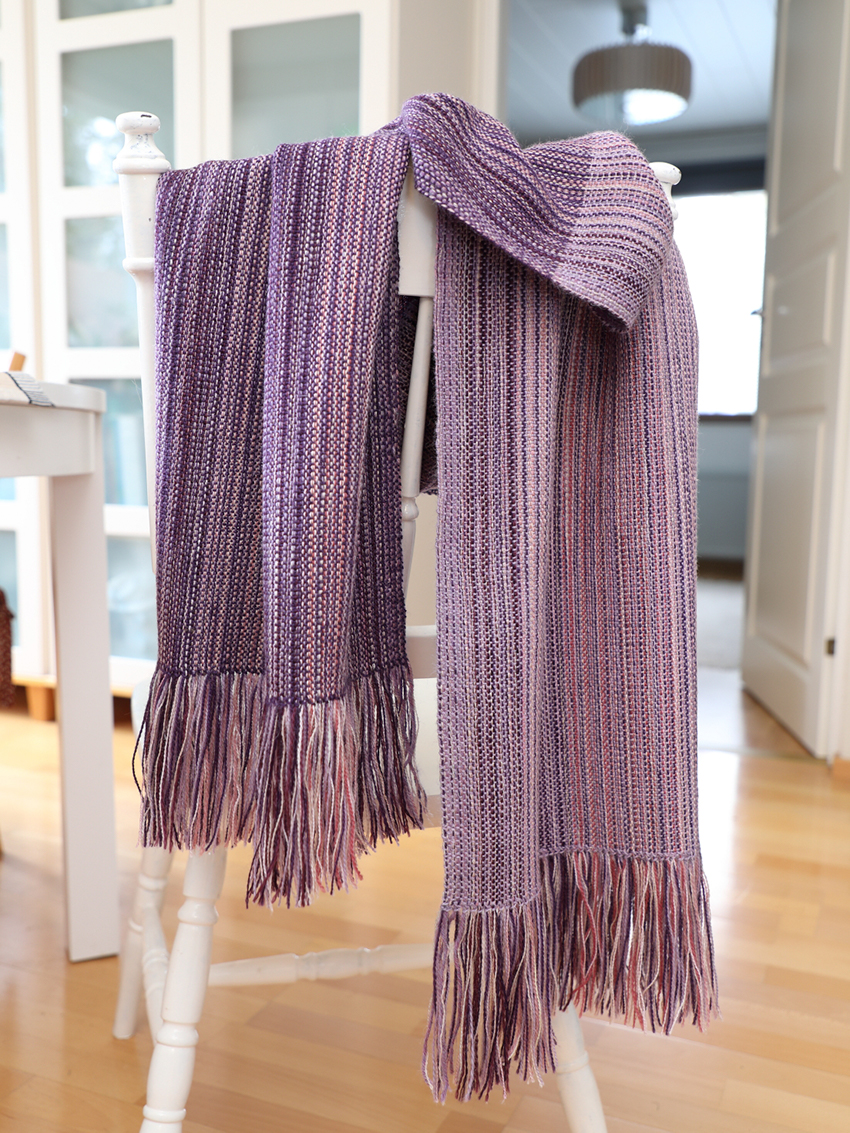
INSTRUCTIONS FOR WINDING THE WARP
Dark purple and light purple Esito worsted wool yarn and light beige Rowan fine lace yarn were included in every portee of the warp. Other yarns were changed. Each portee has 4 single or double yarns (=5-6 single yarns). The thickest yarn, 7-veljestä sock yarn was used very little here and there as an effect yarn. All of the warp yarns have been listed on the next page.
The yarn needed fof the warp was 260 g.
– Make sure to divide different weighted yarns evenly to the width of the warp when winding. This way, the warp will stay even when you’re weaving it.
– Pre-sley two portees in each dent. Two portees = 1 cm
– The ends of each portee will be threaded in random order in two heddles. Each heddle has 2-3 threads.
– Sley threads in each heddle to the same dent of the reed
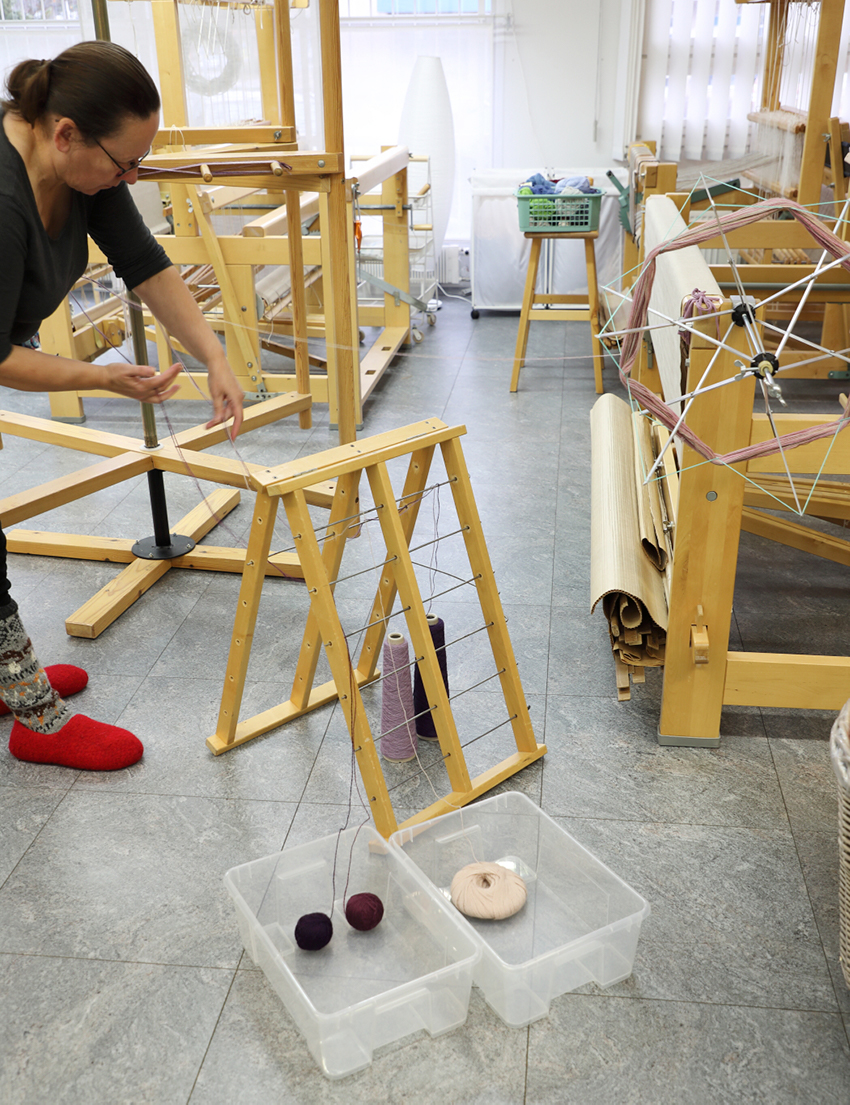
Each portee has 4 single or double yarns (=5-6 single yarns). Make sure to divide different weighted yarns evenly to the width of the warp when winding. This way, the warp will stay even when you’re weaving it.
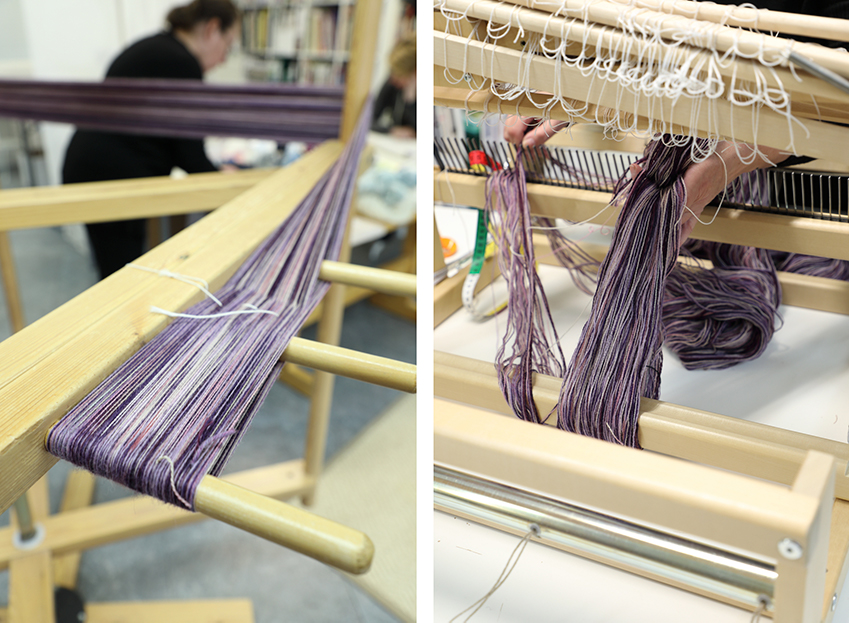
Pre-sley two portees in each dent. Two portees = 1 cm
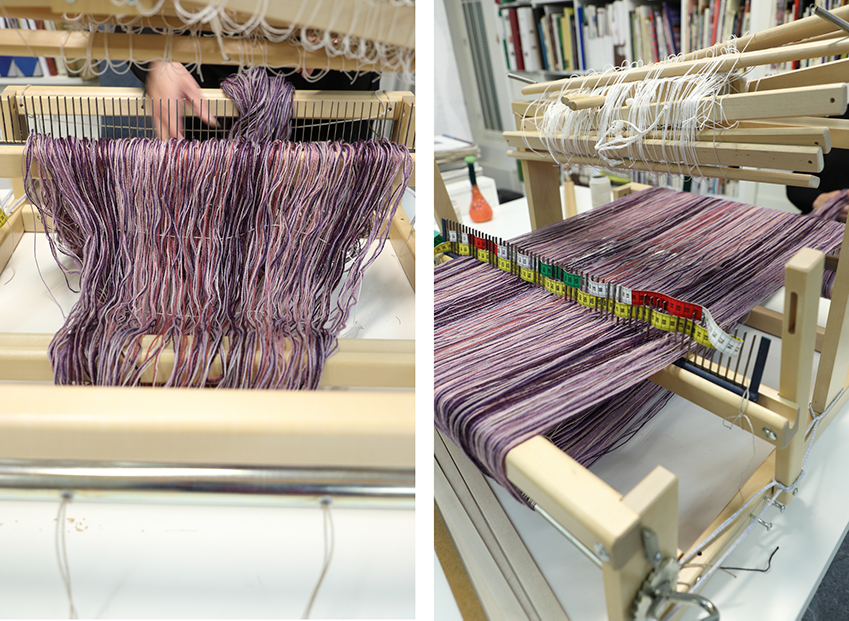
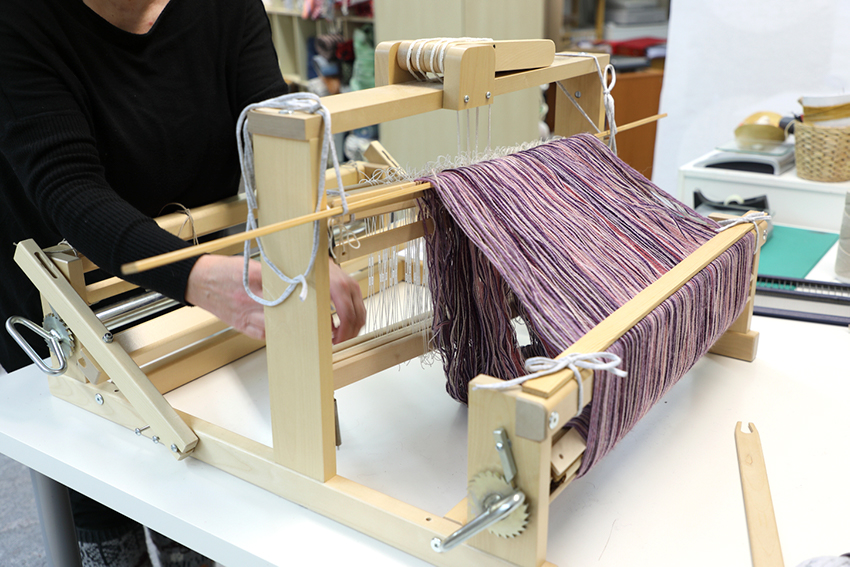
The ends of each portee will be threaded in random order in two heddles. Each heddle has 2-3 threads.
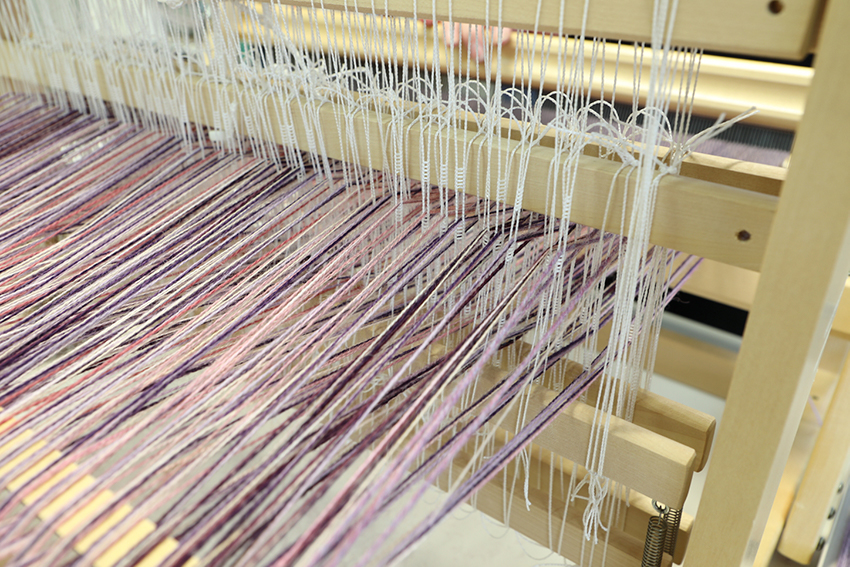
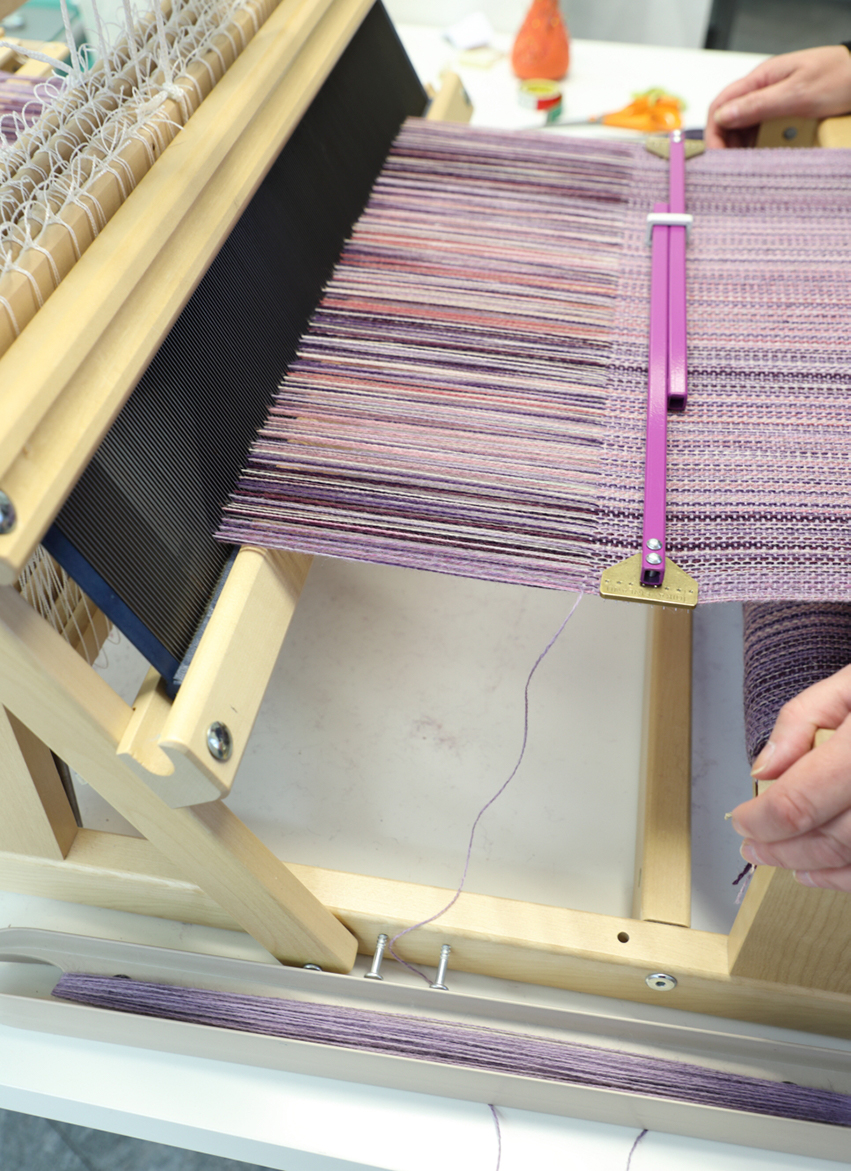
Weaving instructions
Weave a couple of picks with scrap yarn at the beginning and end of the scarf. Weave the scarf with some of the fine yarns used in the warp. We wove the scarf with light purple Esito worsted yarn as far as we could, until we run out of it. The rest of the scarf was woven with dark purple Esito worsted yarn. The yarns used for the weft were the same that were included in the warp all the way. The woven length is 194 cm. The yarn needed for the weft was 91 g.Finishing
Hemstitch the ends of the scarf with the weft yarn. Use a blunt needle. Remove the scrap yarn from the end of the scarf while stitching. Place the scarf on the table fringe, pointing away from you. Stitch from left to right. 1. Poke the needle down through the cloth two wefts from the edge. Come up diagonally two warp threads to the right and two wefts up in the edge. 2. Poke the needle down two warp threads to the left in the edge. Come up two warp threads to the right in the edge. Tighten the stitch. Repeat steps 1 and 2. Cut the fringe to an even length. Steam the scarf. Wash by hand according to the washing instructions of yarns used.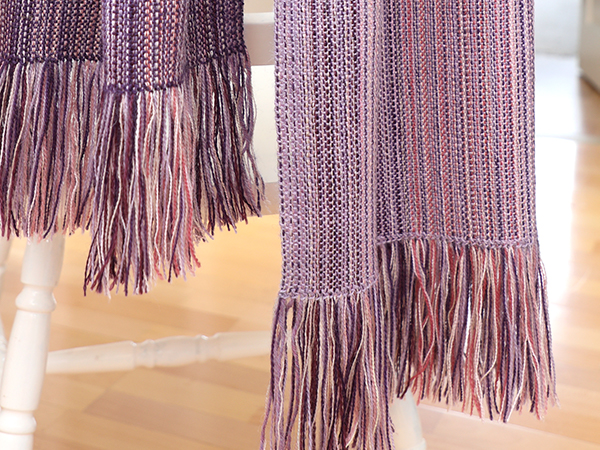
Hemstitch the ends of the scarf
The fringe of the scarf has been finished by stitching. The fringe of the dense warp stays straight and follows the line of the warp stripes beautifully.
Stitch from left to right with the weft yarn.
The stitches looks different on frontside and backside. In the picture above are stitces from the backside.
1. Stitch diagonally under two warp threads to the right and two wefts up in the edge.
Remember that some of the warp ends consist of two fine threads.
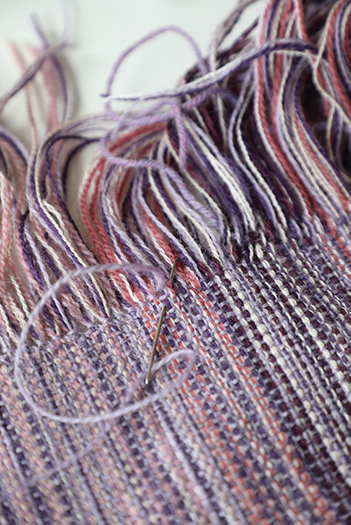
2. Stitch under the same two warp threads from left to right in the edge.
Tighten the stitch.
Repeat steps 1 and 2.
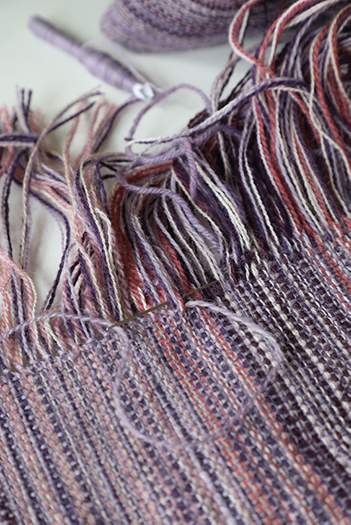
You can leave the ends of the thread into the fringe.



